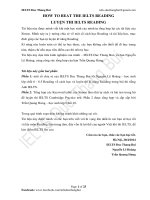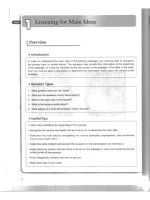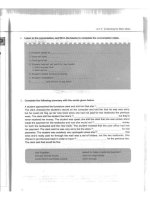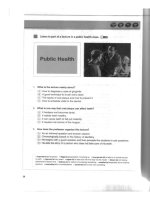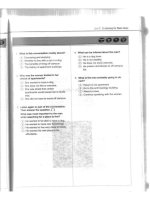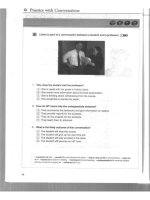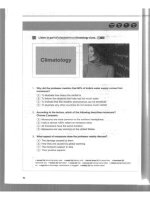How to master the IELTS
Bạn đang xem bản rút gọn của tài liệu. Xem và tải ngay bản đầy đủ của tài liệu tại đây (996.32 KB, 248 trang )
i
How to Master
the IELTS
ii
THIS PAGE IS INTENTIONALLY LEFT BLANK
iii
How to Master
the IELTS
Over 400 practice questions for all parts
of the International English Language
Testing System
Chris Tyreman
iv
Publisher’s note
Every possible effort has been made to ensure that the information contained in this book is accurate
at the time of going to press, and the publishers and author cannot accept responsibility for any errors
or omissions, however caused. No responsibility for loss or damage occasioned to any person acting,
or refraining from action, as a result of the material in this publication can be accepted by the editor, the
publisher or the author.
First published in Great Britain and the United States in 2012 by Kogan Page Limited
Apart from any fair dealing for the purposes of research or private study, or criticism or review, as permitted
under the Copyright, Designs and Patents Act 1988, this publication may only be reproduced, stored or tran
smitted, in any form or by any means, with the prior permission in writing of the publishers, or in the case of
reprographic reproduction in accordance with the terms and licences issued by the CLA. Enquiries concerning
reproduction outside these terms should be sent to the publishers at the undermentioned addresses:
120 Pentonville Road
London N1 9JN
United Kingdom
www.koganpage.com
1518 Walnut Street, Suite 1100
Philadelphia PA 19102
USA
4737/23 Ansari Road
Daryaganj
New Delhi 110002
India
© Chris Tyreman, 2012
The right of Chris Tyreman to be identified as the author of this work has been asserted by him in accordance
with the Copyright, Designs and Patents Act 1988.
ISBN
978 0 7494 5636 8
E-ISBN 978 0 7494 5946 8
British Library Cataloguing-in-Publication Data
A CIP record for this book is available from the British Library.
Library of Congress Cataloging-in-Publication Data
Tyreman, C. J.
How to master the IELTS : over 400 practice questions for all parts of the International English Language
Testing System / Chris John Tyreman.
p. cm.
ISBN 978-0-7494-5636-8 – ISBN 978-0-7494-5946-8 1. International English Language Testing System.
2. English language–Textbooks for foreign speakers. 3. English language–Examinations–Study guides.
I. Title.
PE1128.T97 2012
428.0076–dc23
2011048826
Typeset by Graphicraft Ltd, Hong Kong
Printed and bound in India by Replika Press Pvt Ltd
v
Contents
Introduction 1
TEST 1 11
Listening (1) 12
1. Student accommodation/homestay provision 12
2. Campus plan for the Open Day 14
3. Numeracy week 15
4. Tropical storms/naming hurricanes 17
Reading (1) 18
1. Shedding light on it 18
2. Taking soundings 21
3. Oxbridge 24
Writing (1) 28
1. Fuel usage 1800 to 2000 (graph) 28
2. Electronic calculator use 29
Speaking (1) 30
1. Hobbies 30
2. Food you like 30
3. Convenience food 31
TEST 2 33
Listening (2) 33
1. Walking tour/revised booking 33
2. Field trip/timetable 35
3. Poster presentation 37
4. History of diagrams/flow charts 39
vi
CONTENTS
Reading (2) 41
1. Rosetta Stone 41
2. Tickled Pink 44
3. Bubbly and burgers 47
Writing (2) 51
1. Housing owned and rented in the UK (pie chart) 51
2. Unemployment 52
Speaking (2) 53
1. Travelling to work 53
2. Where you live 53
3. Choosing where to live 54
TEST 3 55
Listening (3) 56
1. Camping and caravan park 56
2. Volunteers weekend 57
3. Work placements 58
4. Darwin/Galapagos Islands 60
Reading (3) 61
1. Recalling it 61
2. Home-schooling 65
3. Bio-fuels backlash 69
Writing (3) 74
1. Internet activities by age group (table) 74
2. Obesity 75
Speaking (3) 76
1. Pets 76
2. Memorable holiday/vacation 76
3. Work and play 77
TEST 4 79
Listening (4) 80
1. Library registration/library policy 80
2. Travelling by train 82
CONTENTS
3. Home composting 84
4. Academic essays 86
Reading (4) 87
1. Hacked off 87
2. Highlands and islands/map of the Western Isles 90
3. Dummy pills 95
Writing (4) 99
1. Waste disposal in four towns (bar chart) 99
2. Success in life 100
Speaking (4) 101
1. Educational achievements 101
2. Describe a book 101
3. Reading books 102
General Reading and Writing Test A 103
General Training Reading Test A 103
1. Check-in procedure at Stanza airport/You’re fired! 104
2. Newview Hotel terms and conditions/a proper brew 108
3. Vertical transport 112
General Training Writing Test A 115
1. Letter to a friend 115
2. Advantages/disadvantages of a gap year 116
General Reading and Writing Test B 117
General Training Reading Test B 117
1. Use the right type of fire extinguisher!/contract of employment 117
2. How to create a blog/print, copy and scan 122
3. Old dogs and new tricks 126
General Training Writing Test B 130
1. Email letter of complaint 130
2. Should children wear a school uniform? 130
Audio-Scripts for the Listening Tests 131
vii
viii
CONTENTS
Answers 167
Marking scheme 167
Test 1 168
Test 2 174
Test 3 180
Test 4 186
General Training Test A 192
Test B 196
Reading section expanded answers 201
APPENDIX 1 Reading section vocabulary 227
APPENDIX 2 British and American spellings 239
MP3 files for these tests can be downloaded for free at
www.koganpage.com/editions/how-to-master-the-ielts/9780749456368
1
Introduction
T
he IELTS is the world’s most popular test with over 1.5 million people taking the
test each year. It is intended for people who wish to study or work in an Englishspeaking country. You have the choice of two modules. The Academic module is
for university degree course applicants. The General Training module is for people
intending to migrate. This book contains four complete practice tests for the Academic
module of the International English Testing Language System (IELTS) with additional
tests for the General Training module. The tests provide IELTS candidates with plenty
of realistic practice because they are similar in style and content to the University of
Cambridge ESOL examinations.
Frequently Asked Questions (FAQs)
1. Where can I sit the IELTS?
You can sit the test in more than 130 countries at 800 test centres. Please visit the
IELTS website at www.ielts.org to find a test centre near to you.
2. When can I sit the IELTS?
Tests are available every month of the year on fixed dates. There are 48 test dates for
the Academic module and 24 test dates for the General module, but this does not
mean that every centre offers a test on every date. The listening, reading and writing
2
How to Master the IELTS
tests are taken on the same day. The speaking test may be on the same day as the
other three tests or it can be up to seven days before or seven days after.
3. How do I register for the IELTS?
To register for the test you need to download a copy of the IELTS application form
(PDF file) or ask your test centre for a copy. You need to return:
●●
a completed and signed application form;
●●
your fee for the test (payment by credit/debit card is widely accepted;
some centres accept online payments and some accept a cheque/postal
order);
●●
a photocopy of your passport (or a photocopy of an EU National ID card);
●●
two identical, colour, passport-size photos that are less than six months old,
and without glasses being worn.
4. How much does it cost to sit the IELTS?
The fee for the IELTS varies from one country to another. As a guide, the fee for the
tests (both Academic and General) was £115 in the UK in 2011. Some countries
accept online applications and payments.
5. What do I need to take to the exam?
You must take the following:
●●
a valid passport (or an EU National ID card), not a photocopy;
●●
at least two pens, two pencils, an eraser and a pencil sharpener (but no pencil
case);
●●
water to drink, in a transparent bottle.
If you sit the speaking test separately – for example, the following week – you must
take your ID again. You must not take your mobile phone into the examination room.
6. When are my results available?
Normally online 13 days after your test date. The official Test Report Form will also be
mailed to your address after this time.
Introduction
7. How many times can I sit the test?
You can sit the test again as many times as you like and as soon as you like,
but you have to sit all four sections of the test. You cannot retake just one module
again, for example the speaking test.
8. How long is the result valid for?
Your IELTS score is valid for two years. You may have to sit the test again if your test
result is more than two years old.
9. What band score do I need?
The IELTS is scored from 0 to 9. You need to check with your university or institution
what band score they need. University degree course applicants should aim
for a band score of 7.0 or higher. The band score for people who wish to work and
live in another country is usually 5.0 or higher.
10. What is the test format?
The test is split into four sections that cover the four key English skills of listening,
reading, writing and speaking. The breakdown of the questions within each of the
four sections is as follows:
●●
Listening Section (Academic and General modules) 40 questions
– Four listening sections: 1, 2, 3 and 4, with 10 questions per section
– Time allowed: 30 minutes.
●●
Reading Section (Academic module) 40 questions
– Three reading passages: 1, 2 and 3, with 40 questions in total (eg 13, 13, 14)
– Time allowed: 60 minutes.
●●
Writing Section (Academic module) 2 tasks
– Task 1 (at least 150 words); eg describe the information in a graph or chart
– Task 2 (at least 250 words); eg argumentative topic; reasons for and
against
– Time allowed: 60 minutes (eg 20 minutes on Task 1 and 40 minutes on
Task 2).
3
4
How to Master the IELTS
●●
Reading Section (General Training module) 40 questions
– Section 1: Two short texts of factual information; eg English in a social
setting
– Section 2: Two short texts of factual information; eg English in a work
context
– Section 3: One longer passage of text of general interest
– Time allowed: 60 minutes.
●●
Writing Section (General Training module) 2 tasks
– Task 1 (at least 150 words); eg write a letter on the chosen topic
– Task 2 (at least 250 words); eg argumentative topic; reasons for and
against
– Time allowed: 60 minutes (eg 20 minutes on Task 1 and 40 minutes on Task 2).
●●
Speaking Section (Academic and General modules) 3 parts
– Part 1: Familiar topics; Part 2: Brief talk; Part 3: Discussion
– Time allowed: 11 to 14 minutes.
Book format
The questions in this book are numbered from 1 to 400 to make every answer easy to
find. The main Answer section is found at the end of the book before the Appendices.
There are two appendices: Appendix 1 is the Reading section vocabulary; Appendix 2
lists British and American spellings. The IELTS practice tests in this book are set out
as follows:
Test 1: Questions 1 to 80; Test 2: Questions 81 to 160; Test 3: Questions 161 to
240; Test 4: Questions 241 to 320
General Training Reading and Writing Test A: Questions 321 to 360
General Training Reading and Writing Test B: Questions 361 to 400
Introduction
Listening Test instructions
MP3 files for these tests can be downloaded for free at www.koganpage.com/
editions/how-to-master-the-ielts/9780749456368
The IELTS practice tests in this book start with the Listening Test as does the
actual test. Your CD player or computer must be able to play MP3 files. There are 16
separate recordings – four for each practice test. Section 1 is conversation between
two people. Section 2 is a talk given by one person (monologue). Section 3 is a
conversation between two or more people and Section 4 is another monologue.
If you want to know more about what to expect then turn to the audio-scripts at the
end of the book. Note that the answers to the listening tests have been underlined
in the audio-scripts.
You will be allowed approximately 30 seconds to study the questions before the test
begins. Use this time to check what types of answers are needed (for example,
dates, times, names, money, etc), and pay special attention to the first question.
Several sentences of dialogue may take place before you hear the words needed
to answer the first question. If you miss the start point and fail to answer the first
question you will not be ready to answer the second question. You will hear the
recording only once, so if you think you have missed an answer you must move on
to the next question. If you look at the audio-scripts you will see that each script
is split into two parts separated by a dashed line; there is a 30-second gap at this
point (first three scripts). Use these 30 seconds to read the next 10 questions.
You will be given a piece of paper on which to write your answers. At the end of the
listening module you will have 10 minutes to transfer your answers to the answer
sheet. Finally, be aware that the Listening Test tests three skills of English language.
You need to listen to the dialogue, read the questions and write the answers. Marks
are needlessly lost when the candidate fails to read the instructions, or transfers
them incorrectly to the answer sheet.
Example: write NO MORE THAN ONE WORD OR ONE NUMBER for each
answer.
Question: How many weeks must be spent in the Halls of Residence?
Answer: 40 weeks x Answer: 40 ✓
5
6
How to Master the IELTS
Example: write NO MORE THAN ONE WORD AND/OR A NUMBER for each
answer.
Question: How many weeks must be spent in the Halls of Residence?
Answer: more than 40 x Answer: 40 weeks ✓ Answer: 40 ✓
Target: aim for at least 30 correct answers out of 40 questions in these practice
tests.
Reading Test instructions
You have one hour to complete 40 questions on three passages of text, or 20 minutes
per test. Do not waste time reading the passage from beginning to end before
looking at the questions. The reading test is a test of word recognition rather than
a test of understanding. To answer many of the questions you need to look for a
word or a string of words that have a similar meaning to those of the question.
The word/words for your answer will match with/map to statements made in the
passage. This means that you need to study the first question carefully, then read
the passage of text, starting at the beginning. You can expect to arrive at the answer
within a few sentences. The answer to the second question will come later in the
passage and the answer to the third question will usually come later still, and so on.
Example:
Statement: Changes in the earth’s magnetic compass can lead to mistakes
in ...
Passage: The stranding of whales in shallow water and on beaches is not well under
stood but it can occur for entirely natural reasons. One explanation involves the
ability of whales, like many animals, to use the earth’s magnetic field for direction
finding. Ocean currents are thought to cause fluctuations in the earth’s magnetic field
which may leave whales vulnerable to navigation errors when they migrate to their
breeding ground.
Method: the word mistakes in the statement means the same as the word errors in
the passage, so the answer is probably navigation; mistakes in navigation matches
with navigation errors. Now check the rest of the sentence to confirm the match:
Introduction
changes are the same as fluctuations and the earth’s magnetic compass is the same
as the earth’s magnetic field, so the answer must be correct. Answer: navigation.
An alternative word for navigation is ‘direction’, that is to say mistakes in direction,
but this is wrong because the word ‘direction’ does not appear in the passage
of text.
Target: aim for at least 30 correct answers out of 40 questions in these practice
tests.
Writing Test instructions
If the question involves a graph or a chart (Task 1) make sure that you understand
what the two axes show. Do not panic and become confused. Start by writing about
one element of the chart (eg one line or one bar), choosing the largest first or the
one with the largest change. Now move on to describe another element and make
a comparison with the first element where there is an obvious difference. Continue
like this with the remaining pieces of information. The timeline is always the bottom
axis (x-axis) and the size is always the vertical axis (y-axis). The time reads from left
to right and the size increases from bottom to top. To prepare for a question about
a pie chart, make sure that you can describe the size of the portions in terms of
simple fractions and percentages, for example: a half (50%), a third (33%), a quarter
(25%), two thirds (67%), three quarters (75%). You can also make statements like
‘just less than a half’, or ‘slightly more than a quarter’, etc. If you have to describe a
process, for example ‘the natural water cycle’, make sure that you identify the best
point in the diagram to start your description; for example: Water leaves the surface
of the earth by a process of evaporation. Now work logically to the next point in the
process.
When writing about a topic (Task 2), read the question carefully. If the question
asks you to ‘discuss both views’ then you need a balanced argument, so make a list
of ideas for and against the issue, and then give your opinion (I believe; I think). Note
that Task 2 counts for twice the marks of Task 1 so spend twice the amount of time
on it. It is important to write at least 150 words for Task 1 and 250 words for Task 2.
Make sure that you know roughly how much space this takes up with your hand
writing, otherwise you will waste time having to count your words.
7
8
How to Master the IELTS
Speaking Test instructions
You can practise for Part 1 by recording some information about yourself on a dicta
phone, stating your name, where you live, what work you do and what hobbies and
interests you have. You can also talk about your family and friends. Part 1 lasts
between four and five minutes. For Part 2 you will be given a task card containing a
general topic of interest and what you need to cover. You can make your own task
cards from the Speaking Test questions in this book. Practise by recording your
voice on a dictaphone and playing it back to check that it lasts between one and two
minutes. Listen for pauses and hesitation, and check your pronunciation, grammar
and vocabulary. In Part 3, the examiner will engage you in a conversation lasting
between four and five minutes. Remember that you are not being assessed on your
knowledge of the topic, only on your speech.
Ten top tips for IELTS
Listening section
1 Use the reading time to familiarize yourself with the types of answers expected;
for example, a number, letter, word or time.
2 Pay special attention to the first question, so that you know when to begin.
3 If the question asks for answers with one word only, be careful not to add any
extra word or letter by mistake. Pay special attention when choosing between
similar numbers or clock times.
4 Copy your answers to the answer sheet exactly as you have written them.
Make sure that your answers are written alongside the correct question
numbers.
Reading section
5 You have 1 hour to complete 3 passages, so try to keep to 20 minutes
per text.
6 Read the first question and then search for the sentence that contains the
answer; it is often near the beginning of the passage.
Introduction
Writing section
7 Write at least 150 words for Section 1 and at least 250 words for Section 2.
8 Spend about 20 minutes on Section 1 and 40 minutes on Section 2.
Speaking section
9 Practise speaking for 1 to 2 minutes on topics that are familiar to you.
10 Keep practising until you sound fluent.
9
10
THIS PAGE IS INTENTIONALLY LEFT BLANK
11
TEST 1
12
How to Master the IELTS
Listening (1)
Section 1
Questions 1 to 5
Complete the notes below.
Write NO MORE THAN ONE WORD AND/OR A NUMBER for each answer.
Student accommodation
Options:
●● Halls of Residence
– £60 per week
– self-catering
– minimum stay 1
●● Student flats
– owned by private landlords
– at least £75 per week
– need a reference and a 2
●● Homestay
– owned by private landlords
– minimum stay 3
– includes 4
Monday to Friday.
and 5
TEST 1
Questions 6 to 10
Complete the form below.
Write NO MORE THAN TWO WORDS AND/OR A NUMBER for each answer.
Homestay provision
Name:
Mike 6
Address:
108 Archer Park, Middleton, Manchester
Postcode:
7
Tel. number: 8
Smoker: No
Cats: Yes
Dogs: No
Special diet: Yes
(If Yes, please specify 9
Number of suitable providers identified: 10
Details forwarded: Yes
)
13
14
How to Master the IELTS
Section 2
Questions 11 to 20
Look at the diagram and complete the list below it.
Write NO MORE THAN THREE WORDS AND/OR A NUMBER for each answer.
Campus plan for the Open Day
19
18
12
15
20
café
Students’
Union
17
13
11
Campus Road
bikes
14
16
11
Centre
12
Hall
13
Room
14
Services
15
16
17
18
Hall
19
Hall
20
Road
ISC
building
TEST 1
Section 3
Questions 21 to 25
Choose the correct letter, A, B or C.
Numeracy week
21 According to the professor, the purpose of numeracy week is
A to draw attention to the advantages of better numeracy.
B to encourage young people to study more mathematics.
C to stress the importance of numerical skills.
22 According to the professor, there is a link between
A entering higher education and a better paid job.
B retraining and getting ahead in life.
C help with homework and doing well in school.
23 According to the professor, many people
A lack ability with words and numbers.
B are better at mathematics than they believe they are.
C have a very basic level of numeracy.
24 According to the professor, modern numeracy classes
A are mostly about basic arithmetic skills.
B cover maths for the workplace.
C concentrate on money matters.
25 The interviewer wonders if people return to education
A to prove themselves academically.
B to build confidence and self-esteem.
C to make up for failing at school.
15
16
How to Master the IELTS
Questions 26 to 30
Which skills does the professor say are important for learners?
Choose THREE letters from the list A to G.
A calculator skills
B times tables
C equations
D mental calculations
E decimal numbers
F algebra
G measuring.
Questions 29 to 30
Complete the sentences below.
Write ONE WORD ONLY for each answer.
29 Some people find it difficult to read gauges on
30 Many employers use numeracy tests to eliminate the worst
TEST 1
Section 4
Complete the notes below.
Questions 31 to 40
Write ONE WORD OR ONE NUMBER ONLY for each answer.
Tropical storms
Different names
Some names are used in place of each other, which can create 31
Tornado formation
Tornadoes form within thick 32
when warm air meets cold air.
Tornadoes become less frequent towards the 33
coast of America.
Cyclone formation
Cyclones form over oceans warmer than 34
degrees centigrade.
Cyclones rotate in the same direction as the 35
Hurricanes and typhoons
A hurricane in America is called a typhoon in 36
Questions 37 to 40
Write NO MORE THAN THREE WORDS OR A NUMBER for each answer.
Naming hurricanes
A hurricane is a tropical storm with a wind speed above 37
km/h
Before 1940, hurricanes were referred to by their 38
After 1979, 39
Names can be reused after 40
names were chosen in turn.
years.
17



